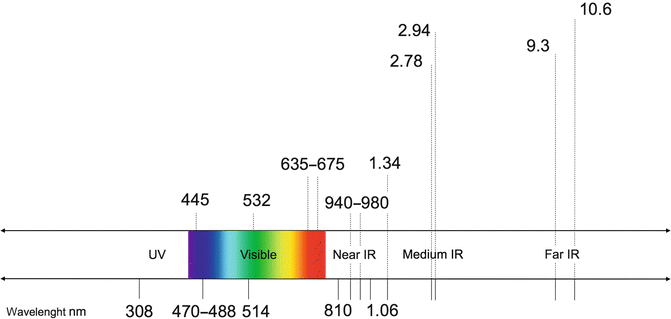Fig. 4.1
Electromagnetic spectrum of radiations
In the visible and invisible infrared spectrum of light, we find the majority of the wavelengths used in dentistry (Fig. 4.2).


Fig. 4.2
Lasers in the electromagnetic spectrum of the light
4.3 Classification of Dental Lasers in the Electromagnetic Spectrum of Light [3]
A classification of lasers considers their position on the electromagnetic spectrum of light according to the wavelength :
-
Laser in the ultraviolet spectrum
-
Laser in the visible spectrum
-
Laser in the near-infrared spectrum
-
Laser in the mid-wavelength infrared spectrum
-
Laser in the far-infrared spectrum (Table 4.1)Table 4.1Classification of lasers according to their wavelength position on the electromagnetic spectrum of lightUltravioletVisibleNear infraredMedium infraredFar infraredExcimer 308 nmBlue diode 445 nmDiode 810 nmEr,Cr:YSGG 2780 nmCO2 9300 nmArgonBlu 470-488 nmGreen 514 nmDiode 940 nmCO2 9600 nmCO2 10,600 nmGreen KTP 532 nmDiode 970 nmRed diode 635–675 nmDiode 1064 nmNd:YAG 1064 nmEr:YAG2940 nmNd:YAP 1340 nm
Another classification identifies the main applications of specific lasers in:
-
Laser for soft tissue applications, laser for hard and soft tissue applications (also called all-tissue laser), laser for low-level therapy, and laser for diagnosis (Table 4.2).Table 4.2Classification of dental lasers according to clinical applicationsSoft tissue lasersHard and soft tissue lasersLLLTDiagnosisDiodes 445 > 1064 nmEr,Cr:YSGGEr:YAGDiodes 445 > 1064 nm405 nm 655 nmNd:YAG, Nd:YAPCO2 9300 nmCO2 10,600 nm
-
Another distinction considers the low-power lasers and the high-power lasers.
4.4 Properties of Laser Light [3]
Light is an electromagnetic radiation which, besides its wave characteristic, has a photonic corpuscular characteristic that transports a defined amount of energy (quantum). A laser device is able to deliver (aim) an elevated quantity of energy in a limited space in the form of light radiation, visible or invisible, generating the laser light.
Laser light is different from ordinary light due to a number of characteristics:
-
It is collimated, that is to say, it has a “one way” direction, thanks to the spatial coherence of emitted photons.
-
It is coherent, that is to say, every photon has the photon phase which determines the emission kept in time and space.
-
It is monochromatic, that is to say, there is just one visible color and just one wavelength.
4.5 Basic Components of Lasers [3]
A laser is composed of several basic elements for the generation and emission of the laser beam. The principal elements of a laser are:
-
Optical resonator (or optical cavity)
-
Active medium
-
Source of energy (or pumping source)
-
Controller (or microprocessor)
-
Cooling system
-
Delivery system
-
Handpiece and tips
4.5.1 Optical Cavity
It is a cavity which contains the active medium and two mirrors located at its extremities, one completely reflective and the other partially reflective and permeable. Photons, emitted by the excitement of the active medium (stimulation), are reflected inside the optical cavity and pass through the active medium many times, amplifying their energy via a waterfall phenomenon (amplification), before exiting (coming out from) the partially permeable mirror.
4.5.2 Active Medium
It is the heart of a laser. The active medium can be solid, liquid, gas, or a semiconductor (diode) and determines the specific wavelength of different lasers; its name identifies different lasers. The atomic population of the active medium, excited by an external source of energy, supplies the electrons for energetic transition from one orbit to another, which produces the emission of laser photons (Table 4.3).
Table 4.3
Reports the active medium of lasers most used in dentistry
|
Laser
|
Abbreviation
|
Active medium
|
Hosting medium
|
Doping atom
|
Wavelength (nm)
|
|---|---|---|---|---|---|
|
Argon
|
Ar
|
Gas
|
–
|
–
|
488 and 514
|
|
Carbon dioxide
|
CO2
|
Gas
|
–
|
–
|
9300; 9600 and 10,600
|
|
Diode
|
–
|
Semiconductor
|
–
|
–
|
445, 635–810 940–980–1064
|
|
Potassium titanyl phosphate
Stay updated, free dental videos. Join our Telegram channel
VIDEdental - Online dental courses
 Get VIDEdental app for watching clinical videos
Get VIDEdental app for watching clinical videos

|